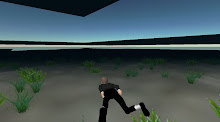I'm trying to remember what I was thinking when I designed Maitland Revolution, my avatar in Second Life. I flashed through skin colors, cheekbones, body sizes, hair and eye colors, clothes, and settled on being male and athletic looking, but not a Mr. America. Maitland was named after a character in a book, but he resembled me in his clumsiness--he had a penchant for falling out of space (not so different than driving off the edge of a highway) and walking underwater. I become confused talking about him because I don't know whether he is in the present or the past, whether he might reappear if I decide to follow him beyond my password (if I can remember it).
Maitland resembles the "'fluid selves'" Lisa Nakamura writes of in the Introduction of Cybertypes: Race, Ethnicity, and Identity on the Internet:
And as Caren Kaplan points out in Questions of Travel, tourists operate from a position of privilege and entitlement (62); to be a tourist is to possess mobility, access, and the capital to satisfy curiosities about "native" life. Chat-space participants who take on identities as samurai and geisha constitute the darker side of postmodern identity, since the "fluid selves" they create (and often so lauded by postmodern theorists) are done so in the most regressive and stereotyped of ways. (xv)
Maitland is stereotyped in that he is an avatar with limited variation from other avatars (unless their creators happen to be computer code gurus. I know that Second Life material/not material and real/not real goods can be designed—can avatars be varied beyond the embedded digital code? Maybe a little mutation here and there, or evolution, given enough time? I know that when bandwidth got sucked up, Maitland lost his clothes and fell on his face. Why not create, god-like, some digital designer genes/jeans?) In a sense, Maitland is stereotyped as one of the avatar race, a cybertype, and “being raced is in itself a disorienting position. Being raced in cyberspace is doubly disorienting, creating multiple layers of identity construction” (xv). Here my exposition dissolves because, in all seriousness, the real issues of race in any space are daunting. I could have decided to make Maitland an avatar of color but I chose not to, and at the same time I made him male but mentally positioned him much as I might position a younger, lither, female me. I don’t remember having the choice of making Maitland obese—chunky, Shwarzeneggerish, yes, but not fat. Is the world of avatars obesity-free? If it is, why? And what of the women—are there any Twiggy-thin female avatars? Ah…and when I was there in Second Life, I saw no children.
No children. Why? Was I in the wrong Second Universe? Or perhaps just as “mythologies of race that are nostalgic” are constructed narratives, so are the childless, fatless, thinless, spaces of online lives like Second Life. They are lives of “‘sadness without an object’” (Nakamura 26).[i]
Angela M. Haas’s Making Online Spaces More Native to American Indians: A Digital Diversity Recommendation speaks to a less theoretical and more practical push for online survivance (I think this might be survival + resistance, although the author writes survivance + resistance.) In other words, Haas is writing that American Indians’ access to the Internet, though limited, is growing, and in this growth, tribes like the Cherokee Nation are establishing online tribal identities they intend to
· preserve language, culture, history, and identity;
· demystify Nativeness and combat stereotypes and fetishism…;
· [and] provide “contact zones” for Natives and non-Natives to foster community and alliance-building.
One of the survivance tactics is digital rhetorical sovereignty, which “gives Natives a reason to be wired” and promotes the development of the items listed above. From my surfing with Jeanette, I have the impression that tribal presence, if not Native presence as a whole, is growing online, and in uniquely Native ways.
1. How can Native American people and tribes avoid being exploited voyeuristically or fetishized as a consequence of online presence?
2. Nakamura writes: “Cybertyping’s purpose is to representatively bracket off racial difference, to assuage fears that the Internet is indeed producing a monoculture. The greater fear, however, which cybertyping actively works to conceal, is the West’s reluctance to acknowledge its colonization of global media, and ongoing racist practices within its own borders” (19-20). Question: Did we learn anything from the American Civil War years that could translate into a peaceable resolution to end “colonization of global media” and “racist practices within [online] borders”?
[i] More than a year has passed since I conjured Maitland’s code and looked at his back. My memory of the “game’s” capabilities may be faulty, and new possibilities are likely to have been programmed in during the intervening period.

![Sig[h]ns](http://bp1.blogger.com/_RkYu0NE8-5U/R6frnRz_BfI/AAAAAAAAABw/ymFHpLR09Ro/S220/U.K.,+Beauty+Lou,+Chelsea,+Coeur+d+Alene+463.jpg)
1 comment:
I'm surprised that I really haven't seen any scholarship on this question:
"Is the world of avatars obesity-free? If it is, why? And what of the women—are there any Twiggy-thin female avatars?"
This is a good question and the implications of the ways in which bodies are represented online is huge. If there are more and more spaces like 2nd Life and games like World of Warcraft, but these spaces are devoid of fat people, then what does that mean? That's troubling to me, and even more troubling I think to little girls today who grow up with just one more space telling them what is 'normal.'
Post a Comment